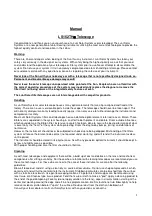
-11-
Make minor adjustments with leveling
screws if necessary.
Final Level Check
Rotate the telescope over each of four
leveling points to be sure the bubble
remains centered.
Rule for Quick and Simple
Leveling
THUMBS IN, THUMBS OUT. Turn
BOTH screws equally and simultaneously.
Practice will help you get the feel of the
screws and the movement of the bubble.
It will also help to remember that the
direction your left thumb moves is the
direction the bubble will move.
Reading the Circle, Arc, and
Vernier
The 360° horizontal circle
6
is divided in
quadrants (0 - 90°). The circle is marked
in degrees and numbered every 10
degrees. The horizontal circle is referred
to as the circle or degree scale. On
level-transits, the vertical arc
14
also is a
degree scale, and it is numbered every 10
degrees to 45 degrees, up and down.
For very precise readings, Universal
instruments are equipped with a vernier
8
and
15
which divides each degree on
the circle or arc into 12 equal parts of 5
minutes each. There are 60 minutes (60’)
in a degree.
The vernier scale
8 and 15
is read in the
same direction (right or left) as you’re
reading the degree scale.
The following examples will explain how to
read the degree and vernier scales on the
circle and arc.
Exact Degree Reading
The point at which 0 on the vernier scale
touches the circle
.
If the 0 coincides
exactly with a degree line on the circle,
your reading will be in exact degrees.
There are no fractions of degrees, or
minutes, to be added to the reading. The
horizontal circle reading is 40°.
The vertical arc
14
is read in the same
way. If the 0 on the vernier scale coincides
exactly with a degree line on the arc, the
reading will be in exact degrees.
Fraction (Minutes) Reading
If the 0 on the vernier does not coincide
exactly with a degree line, your degree
reading is the line which the 0 has just
passed, reading up the degree scale, plus
a fraction of the next degree.


























